Improving soil fertility
There are several approaches to increasing soil fertility in rice production.
First is to prevent soil and organic matter loss. Second is to grow crops that can improve the soil fertility either in rotation or intercropped with rice. The third approach is to plant leguminous cover crops, add manures, compost and other organic amendments directly to the soil to improve the fertility before planting.
Soil conservation
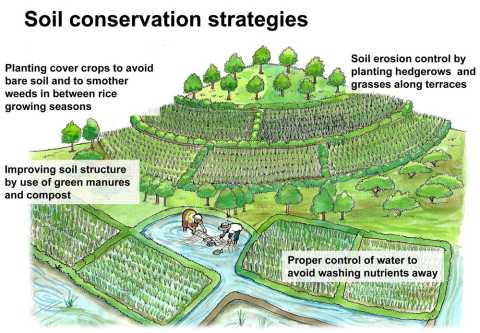
One approach to solving the land shortage problem in rice production is to improve the productivity of the soil. With productive soil, farmers can stay on the same land and cultivate rice for a long time, and reduce the frequency or rate of developing new fields when the fertility of the soil goes down. Some traditional methods of rice production like slash and burn in preparation of the land for planting, the clearing of trees/forests and reclaiming of swamps in search of fertile land for rice production are unsustainable in terms of soil fertility management and environmental conservation. Farmers, therefore, need to conserve the soil organic matter and prevent erosion of the topsoil.
The effectiveness of the agronomic practises applied to prevent loss of soil and conserve soil organic matter will depend on the production system. In up land rice systems in hilly areas, loss of soil on sloping land can be prevented by constructing terraces in the form of hedgerows or boundary strips of grass or stones across the slope. Because of the fragile nature of most tropical soils, minimal disturbance of soil is important to conserve soil organic matter. Ploughing or digging should only be done when necessary, like to break the hard topsoil, while incorporating organic materials like green manures, rice straw or compost into the soil to improve its structure. In addition, cover crops can be used to avoid bare soil and smother weeds in between rice growing seasons.
In lowland systems, a levelled field ensures minimal erosion of the soil and minimises water requirements. Ahead of the planting time, rice straw from the previous harvest and other green material should be ploughed or dug under the soil.
Introduction of leguminous crops into rice production
Planned rotation or intercropping of rice with leguminous crops or green manures improves soil fertility and prevents the buildup of pest populations, diseases and weeds. Leguminous crops (e.g. cowpea, pigeon pea, green gram and soybean) or green manure crops (jack beans, perennial peanut or Mucuna) fix nitrogen and produce large quantities of biomass that can be used to increase nitrogen availability and soil organic matter.
Lowland rice systems
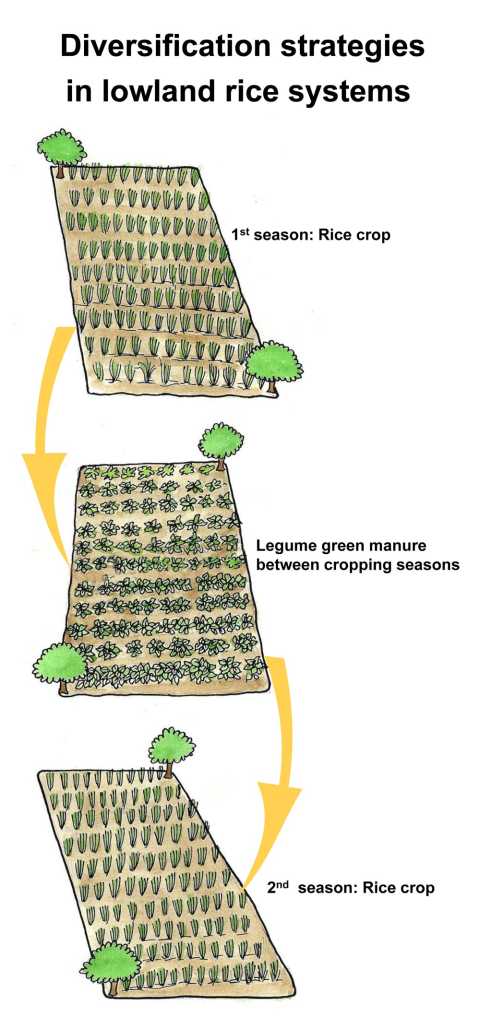
There are limited options for intercropping in flooded lowland rice systems due to the semi-aquatic growing conditions. However, in rainfed areas and in places where water can be drained at the end of the season, other crops can be intercropped or in rotation with rice. For example, rice farmers can plant a legume between the cropping seasons or intercrop with legumes or vegetables. This could be done after harvest of the first rice crop at the time when there is still sufficient soil moisture to allow germination of the legume seeds. Other legumes like mungbean are usually broadcast a couple of weeks before harvest of rice or immediately after harvest. However, integration of legumes can be done in either of the following ways:
- In a one season rice crop, the legume can be planted after harvesting the main crop to take advantage of the remaining soil moisture. The legume (e.g. mungbean or mucuna) is left to grow to full maturity. Then at the start of the rainy season, it is ploughed under the soil.
- In two season rice crops, the legume is planted after harvesting the second crop of rice. It is then planted to serve both as cover crop and green manure. After it attains full biomass, it can be ploughed under to serve as green manure for the next crop.
- The legume may also be grown to control weeds, where it is cut at full vegetative growth, shredded and scattered on the field to serve as green manure.
Upland rice systems
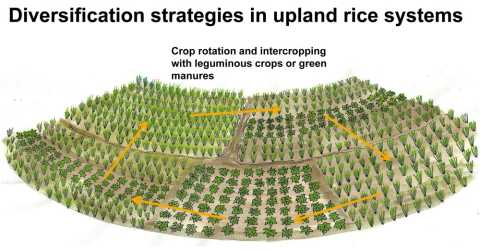
Unlike upland rice systems, there are many opportunities for integrating leguminous crops and vegetables in upland systems:
- Upland rice can be intercropped with several annual leguminous crops, such as beans, peas, mungbean, soybeans and vegetables like okra and eggplants. These crops can simultaneously increase farmers’ incomes and contribute to sustainability of the farming system.
- Green leaf manuring is done by using the fresh biomass of shrubs and trees, which are planted along the rice field boundaries as hedgerows. Tree/shrub species like Tithonia, Crotalaria, Leucaena, Sesbania, Gliricidia or Acacia, grow very fast and have deep root systems whereby they will not compete with the rice, but instead recycle nutrients from deeper layers into their biomass. They also further stabilise terraces in hilly areas.
- Crop rotation is done with leguminous crops or green manures. Green manure legumes serve as cover crops to protect soil surface, increase soil fertility through nitrogen fixation and produce organic matter to improve the soil.
Addition of organic materials
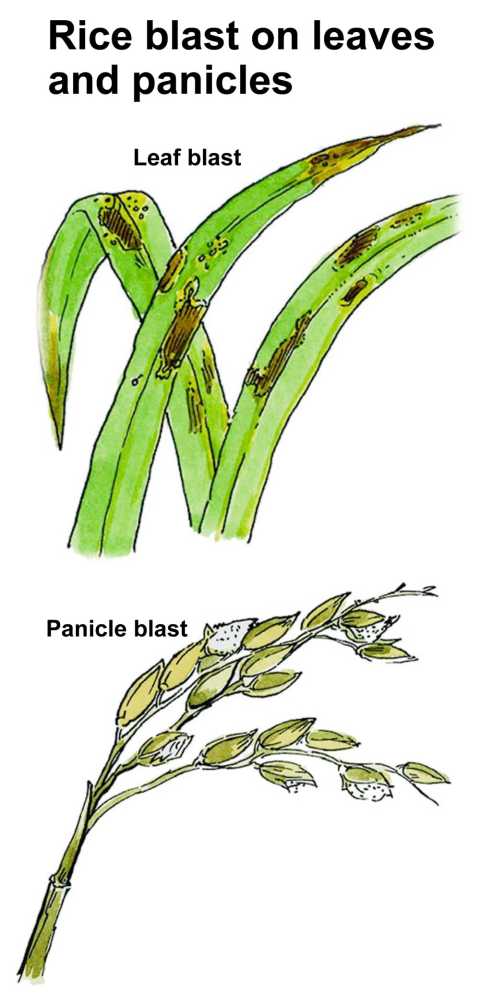
As mentioned earlier, growing rice continuously season after season depletes soil organic matter and nutrients. In many rice growing areas, nitrogen and phosphorus availability are the main limiting nutrients in rice production. Typical symptoms of phosphorus deficiency are stunted plants, reduced tillering and leaf discolouration, while yellowing of leaves indicates nitrogen deficiency. The planting of leguminous cover crops and the use of rock phosphate (RP) can address these issues. The use of indigenous rock phosphate (RP) as fertilizer is be-coming increasingly important as a water-soluble phosphorus fertilizer under suitable environments. The application of RP with manure enhances the solubility of RP in the soil and thus increases availability of P to plants. In association with phosphate-solubilising microorganisms and manure, RP can be used as a P source in many crops.
The soil organic matter acts as a ‘nutrients bank’. It needs to be refilled regularly in order to achieve good yields. This can be achieved through application of organic plant materials, compost or animal manures.
Organic plant materials, animal manures or compost should be applied by spreading in the field before land preparation so that it can be incorporated into the soil.
Compost is a highly concentrated material which supplies soil nutrients for a longer period of time. It also improves the soil structure and increases the water holding capacity of the soil. Therefore, it serves as a good soil amendment, rather than a quick source of nutrient availability to rice. The composting process helps to quickly recycle tough materials like rice straw and rice husks. This is done in combination with animal manure (from pigs, cows, goats or poultry), together with fresh succulent plant material.
At critical growth stages of rice, i.e. during early tillering and panicle initiation, a quick source of nutrients is needed. Therefore, another application of N rich animal manures such as decomposed poultry manure is recommended in order to achieve better yields.
Proper water management
Enough supply of water is needed for optimum rice production in both upland and lowland systems. Proper management of water depends on the rice variety, rainfall patterns, soil properties, management practises and availability of other sources of water.
The water requirement in rainfed upland systems is met by making the most use of the available water from the rains. Therefore, planting of rice should be based on the cropping calendar, so that the stages of growth that need water most (i.e. from panicle initiation to heading) receive maximum rainfall. This will be complemented with reduced tillage practises, mulching and proper water harvesting channels on sloping lands. It is important to establish the time to sow in each season based on the long-term (15 years) daily rainfall pattern or actual trials on optimum sowing date.
Ideally, the water level in irrigated flooded rice needs to be maintained at about 2 cm during most of the growing season, except during the ripening stage.
This is, however, possible only if the producer is assured of access to water whenever it is needed. In many situations this is not the case as the availability depends on rainfall patterns and irrigation is not accessible to many farmers.
Where resources permit, farmers should tap and conserve the available water more appropriately, for example, by creating bunds and channels to trap moving water from uphill into man-made ponds or dams. Such collected water can later be redistributed into the fields in seasons of low water availability.
The System of Rice Intensification (SRI)
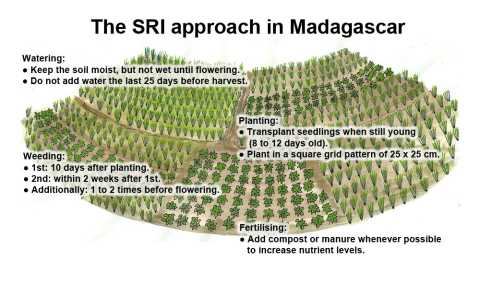
SRI is a methodology for increasing the productivity of irrigated rice by changing the management of plants, soil, water and nutrients. SRI, which originated in Madagascar, leads to healthier soil and plants supported by greater root growth and the nurturing of soil microbial abundance and diversity. In its simplest form, SRI involves:
- Soil only needs to be kept moist during the period of growth when the plant is putting out tillers and leaves, before it begins to flower and to produce grains. During this reproductive stage, the rice plants should be given a thin layer of water (1-2 cm) on the surface of the soil. The field should not be supplied with extra water during the 25 days before harvest.
- Transplanting seedlings when still very young, usually just 8-12 days old, with just two small leaves, done carefully and quickly to have minimum trauma to the roots, putting only one seedling per hole instead of 3 to avoid root competition, and using wide spacing to encourage greater root and canopy growth in a square grid pattern, 25 x 25 cm or wider in good quality soil.
- The first weeding should be within about 10 days after transplanting, and at least one more weeding should follow within two weeks. This will dig up weeds at the same time that it allows more air into the soil for the roots to utilize. Doing one or two additional weedings (3 or 4 weedings in all), before the plants have completed their growth or begin flowering, will provide still more oxygen to the soil. A very simple mechanical weeder, called a rotating hoe, pushed by hand has been developed to enable farmers to eliminate weeds easily, quickly and early. It reduces the hard labour of pulling up individual weeds by hand once they emerge.
- Adding compost or manure whenever possible to add nutrients to the field.
The benefits of SRI, which have been demonstrated in over 40 countries include: increased yield (50 to 100 % or more), a reduction in required seed (up to 90 %) and water savings (50 % or more). Many SRI users also report a reduction in pests, diseases, grain shattering, unfilled grains and lodging. Additional environmental benefits stem from the reduction of agricultural chemicals, water use and methane emissions that contribute to global warming. See SRI website: http://ciifad.cornell.edu/sri/ for more information on country experiences with SRI.
Recommendations for farmers for better water management in irrigated systems:
For efficient water saving in irrigated rice systems, allow water into the field 3 to 4 days after transplanting, then irrigate and drain the field alternately from the seedling stage up to flowering time. Plan to irrigate, especially during the flowering or heading period, which requires adequate water for good yields. Allow the soil surface to dry before irrigating but keep the soil in a saturated state. But avoid leaving standing water of more than 2 cm except in rice-fish systems and construct borders on the rice plots to facilitate proper collection and drainage of excess water. Make sure the water is free of contaminants from conventional fields and is of good quality to avoid soil related problems, like salinity.
Ensure that no inflow of water from any conventional fields exists. But if the field is already contaminated, construct drainage canals to divert the water away, thus minimizing contaminants from entering the plots. Meanwhile encourage all immediate neighbouring farmers to adopt best farming practises and reduce use of expensive pesticides or fertilizers.
Email: Editor@agricinafrica.com

Comments
Post a Comment